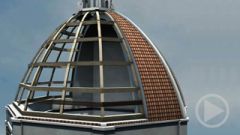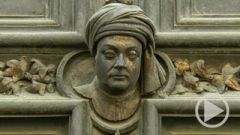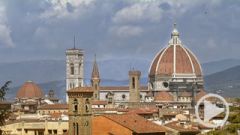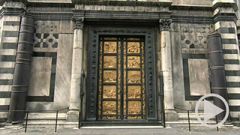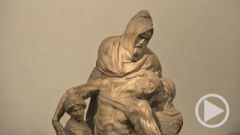The Beginnings: The Baptistery – Giotto’s Campanile
A shimmering, dazzling expanse of marble. One of the most stunning church towers ever built, illustrious grand and elegant. Immortal works of art that transport us to a divine realm. And all this crowned with an architectural masterstroke unsurpassed to this day. Florence Cathedral – a vehicle to express the pride of the citizens of Florence, as well as being a monument to their faith. Generations of Florentines participated in its construction, in the knowledge that they would themselves not live to see its completion. They toiled in honour of god and the glory of their city – for 170 years.
The cathedral radiates a timeless beauty, and gives expression to a unique period in the spiritual history of the Occident, a time in which people began to view both God and themselves in a completely new light. And not least, the cathedral is rock-solid proof of the fact that an individual can sometimes achieve the apparently impossible – and thereby usher in a new cultural epoch.
In the late 14th century, a little boy is growing up in the alleyways of Florence. Everyone calls him Pippo, although his real name is Filippo. It’s an exciting time. Florence is in its heyday, the city is one of the largest trading hubs in Europe. It’s ruled by powerful guilds – the most wealthy of these being the “Arte della Lana”, or wool guild. Members had become trade magnates responsible for arranging the weaving of sumptuous woollen cloth and its export across Europe.

The city is bristling with new constructions, imposing churches and magnificent palaces. Near Pippo’s house, too vast brick walls are shooting up skywards – the tallest of them all: the walls of a new cathedral. Every day Pippo passes the building site. His father Ser Brunellesco is a city dignitary, and Pippo dreams of one day becoming a famous master builder and completing the monumental construction.
The people of Florence have already been working on the new church for 80 years. The square where it is located has been a sacred district for many hundreds of years. In Roman times, it was actually situated on the outskirts of the town. In the 5th century the first church within the city walls was built here directly alongside the northern city gate, with a baptistry and bishop’s palace in front. This formed what was known as the “asse sacro”, or “sacred axis”.
Archeologists excavated the foundation walls of the ancient church around 40 years ago, beneath the floor of today’s cathedral. Their work revealed the remains of a typical late Roman basilica – adorned with wonderful mosaics. It had been dedicated to the Saint Reparata, an early martyr from Palestine. The church of Santa Reparata was renovated and modified several times over the course of the centuries. It was finally upgraded to a cathedral in the 12th century, after the bones of Saint Zenobius were brought here. He is venerated as the first bishop of Florence and is to this day one of the city’s patron saints, together with Reparata and John the Baptist.
In Roman times, the baptistery opposite Santa Reparata was smaller than the current building, but octagonal just as it is today. And that was no coincidence. The number eight is a symbol of eternal life: God created the world in six days, the seventh was a day of rest – and the eighth will be the day of his second coming. This symbolism was particularly explicit in the Middle Ages, because the chapel was surrounded by a cemetery at the time. This meant that one had to traverse the zone of death to be cleansed and reborn as a Christian in the baptism ceremony.
In the mid-11th century, Florence went through of a major economic and political boom. In the year 1059 the Florentines also began enlarging their baptistery. It became the city’s pride and joy – the great poet Dante named it “mio bel San Giovanni”, or “my beautiful Saint John”. With a diameter of 26 metres, the cupola was the largest in medieaval Europe. The magnificent mosaics also testify to the city’s wealth at the time. In keeping with the tradition of Byzantine icons, they are set against a background of pure gold – a symbol of the glory of God. They display the entire history of the world in 59 tableaux, beginning with the creation. In the second row, they relate the story of Joseph, one of the progenitors of the chosen people of Israel. Scenes from the life of Jesus follow. The lowest row of mosaics shows the story of John the Baptist. He baptised Jesus, and the baptistery has thus been dedicated to him.

The most important mosaics above the altar take up the theme of rebirth through baptism: in the centre the figure of Christ with the stigmata – risen from the dead. Beneath him, on Judgement Day, the dead also arise again. But they are divided: on his right, Christ invites the righteous into paradise, to eternal life in the sacred fold. On his left, however, Christ shows the back of his hand in a gesture of rejection. And beneath this hand the sinners are burnedburn in hell.
These mosaics were created between 1220 and 1290, and still adhere to the style of the Middle Ages. We know that some of them are the work of craftsmen from Venice, a place where artists maintained the Byzantine mosaic tradition. But we don’t know any of the artists by name. In medieaval times, it’s the work itself that matters. It’s the images and their message that are important, and the artists are simply craftsmen who carry out the will of God. This is why they don’t usually sign their work.
A legend claiming that the baptistery was once a Roman temple persists to this day. It’s a legend that does contain a grain of truth: the pillars and many of the marble slabs do indeed date from the Classical Antiquity.
The glorious new baptistery even served as a temporary cathedral, while the old cathedral of Santa Reparata was left to go to rack and ruin. The Florentines were busy building up their trade empire – culture would have to to take a back seat. That attitude changed at the end of the 13th century.
Florence was now one of the largest cities in Europe, a fact that should at last be reflected by the cathedral. Siena and Pisa had already upped the ante building spectactular new churches. The Florentines were not about to be outshone any longer. The city needed a new cathedral – a “state church” in keeping with the status of Florence.

In the year 1296, the commission for its construction was awarded to Arnolfo di Cambio – one of the most influential architects and sculptors of the Middle Ages. He was municipal architect of Florence at the time, and the designer of several buildings including the Palazzo Vecchio. Arnolfo conceived a typical Gothic cathedral, one that differed from traditional designs in one respect: at its eastern end it did not consist of the usual transept and choir, but of three apses that took up the octagonal form of the baptistery - in what’s known as a Triple Apsidal Church.
But Arnolfo died just 15 years after construction work began. At the time, the walls of the new nave were rising up around the old cathedral. At the west wall, Arnolfo had designed a Gothic façade with pillars, reliefs and statues. At the time of his death, it had been completed as far as the top of the portal – and it would stay that way for centuries. This is also how it would have looked to little Pippo Brunelleschi around the year 1380: a half-finished Gothic façade that had already begun to look rather dated.

After Arnolfo’s death, the cathedral project was shelved for some 20 years. In 1331, the adminstration of the cathedral construction project, or “Opera del Duomo”, was passed to the wool merchants’ guild. These people had economic clout, and got things moving again at last.
Giotto di Bondone was appointed as Arnolfo’s successor. He was principally famous as a painter, and the founder of a completely new technique: instead of the symbolic images of the Middle Ages, Giotto painted the world in its true form, vividly and vibrantly. People had never seen anything like it – and Giotto became a the pioneer of Renaissance painting style. His main contribution to Florence cathedral was the design for the new bell tower. Construction work officially began on July 19th 1334 – but Giotto was to die just three years later. Only the lowest section of his Campanile had been completed.
But the master had already introduced his successor several years before. The wool barons wanted to replace the main wooden portal of the baptistery with a bronze door. On Giotto’s recommendation, the sculptor Andrea Pisano was awarded the commission – and he created a masterpiece.
Pisano sub-divided both doors into 28 sections. The lowest sections show the Seven Virtues and Humility – all of them additionally identified with Gothic inscriptions. The upper 20 sections relate episodes of the life of John the Baptist – the central motif of the entire baptistery. The story begins up on the left, where an archangel informs Zacharias of the birth of his son John.
The baptism of Jesus represents the zenith of John’s life, as his most important task in the story of salvation. That’s why Andrea set this particular scene at eye-level. And it’s a scene that encapsulates the master craftsmanship of its creator: Christ is standing in the Jordan River, and the underwater refraction has been perfectly rendered in the relief. The last panels depict the death of John, which begins with the dance of Salomé. As a reward for her performance, she requests the head of the Baptist. The gruesome idea comes from her mother Herodias: John had dared to criticise the queen – and in revenge, she gets his head.

Andrea completed these wonderfully vivid doors in the year 1336. Four years later, he was appointed new chief cathedral architect. Like Giotto, he focused his efforts on the tower. He built two further sections, and adorned them with rows of relief panels.
The cycle begins on the western side with the creation of Adam and Eve. After their expulsion from paradise, humans must earn their bread by the sweat of their own brow. They soon find ways of making life easier. For example, they start to keep animals – according to the Bible, Jabal is the first cattle breeder. His brother Jubal invents music. This was Andrea Pisano’s central theme: the creativity of human beings, inspired by God. And logically, for the first time we see depictions of the practical arts here –architecture, for example. This was something quite new: like all manual work, since Antiquity it had been regarded as a “lower art form” unworthy of an educated man. But Pisano’s reliefs show that people were now becoming more self-assured, and that manual work also found recognition.

Pisano devotes an individual medallion to the invention of weaving – a nod to the guild of wool magnates, which had after all commissioned the project. In the upper levels, the panels are not octagonal, but diamond-shaped. They portray allegories of the planets and on the north side the seven sacraments, some of them the work of Andrea’s assistant Maso di Banco. Pisano’s reliefs display a spatial depth similar to that found in paintings by Giotto – so similar in fact that some wonder if the designs were not actually the work of Giotto himself. On the eastern side on the upper level the virtues, and finally the pinnacle of human inventiveness: the Seven Liberal Arts – symbolically portrayed such as here for example, Grammar. Andrea Pisano died after building two new sections of the tower. His successor Francesco Talenti eventually completed it in 1359. He had again added three sections – this time with large Gothic windows and dispensing with any further figural ornamentation. This way, he gave the tower its elegant airiness.
At last, Francesco Talenti now focused his energies on the cathedral proper again. He may have taken over Arnolfo di Cambio’s designs, but he made them even more monumental. This is especially evident today from the windows: the most westerly are the work of Arnolfo, they are lower and more slender. Talenti’s designs included broader arches, which consequently made the windows larger.
After these changes, the wool traders now had to agree on a final blueprint for the cathedral. And the way to do that was the same then as it is now – through an architectural competition. It says a lot about the atmosphere in Florence at the time that the winner of this competition was not the cathedral’s master builder Talenti himself, but a group of artists, which included architects, but above all painters. Their new design set down an idea that most likely came to Arnolfo too: to embody the greatness of the city of Florence, a mighty cupola would rise up over the cathedral crossing. The Florentines were very impressed. There was just one problem: no one knew how to build such a cupola.


